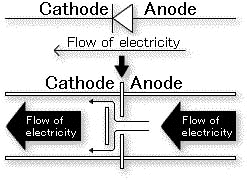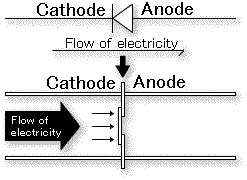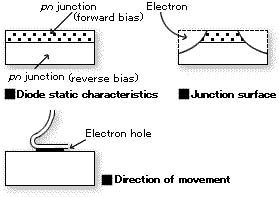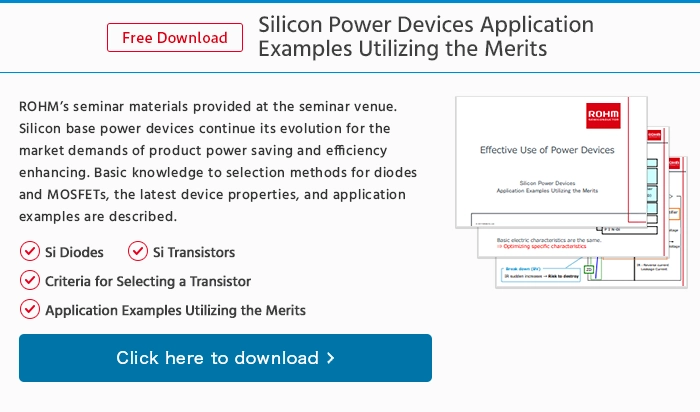What is a Diode?
<Diode Fundamentals and History>
Tale of a Diode
Below we have compiled some of the history and principles behind diodes. If you feel it's necessary, give it a glance to refresh your memory. "Well I already knew that!" is what some of you are thinking, and if that is the case, feel free to skip this section. Before we get into some of the properties and fundamentals of diodes, let's talk about the Edison effect.
The Edison effect happens when electrons would flow from a heated element to a cooler metal plate, in a vacuum. When Edison discovered this, he didn't really see a use for it, but went ahead and patented it anyway. Edison patented everything in sight. The more descriptive term, "thermionic emission" is used to describe this effect today.
Now the Edison effect has an interesting feature. The electrons can flow only one way. Only from the hot element to the cool plate, never the opposite way. A good comparison would be water flowing through a check valve. We call devices that allow electricity to flow only one direction, diodes.
Before the Vacuum Tube
Rectifying properties and the Edison effect were discovered in the two-pole vacuum tube in 1884. Eight years before that, the rectifying effect of selenium was discovered in 1876. The history of using properties of semiconductors to create diodes that possess rectifying effects is very old. It may be hard to believe, but the history of semiconductors dates back before that of the vacuum tube!
From Germanium to Silicon
The first primitive diodes, like the selenium rectifier or crystal detectors, used iron pyrites and galena as well as other natural copper oxides (polycrystalline semiconductors). As refining techniques advanced, we entered the age where highly sensitive single crystalline semiconductors could be produced with reliability. The age of germanium and silicon diodes. During this time, we learned that germanium has a low resistance to heat, and so in today’s world, most semiconductors are made with silicon. Semiconductor diodes play a crucial role in modern electronics, with applications ranging from use in automotive and industrial equipment to use in devices such as smartphones and computers.
Rectification From the PN Junction
The diode element consists of a structure called the pn junction. The terminal attached to the p-type semiconductor is called the anode, and the terminal attached to the n-type semiconductor is called the cathode. Rectifier diodes allow current to flow from the anode to the cathode, but almost completely prevent it from flowing in the reverse direction. This phenomenon is called rectification, and, put simply, it converts alternating current to a unidirectional current. The current flow in this process is crucial as it ensures that the diode conducts in one direction while blocking it in the other.
Diode model


Diode schematic electrical symbol

In Other Words, a Diode is a Valve!
As previously mentioned, if you were to think of an image that exemplifies the effects of a diode, you might think of it as a “valve” for electrical current. If you think of electrical current as flowing water, the anode could be considered the upstream side and the cathode the downstream side. Water flows from upstream to downstream (or shall I say, the electrical current does), but the “valve” prevents it from flowing from downstream to upstream. This is the principle operation of a diode.

●The valve is open and electricity flows
(forward direction)

●The valve is closed and electricity does not flow
(reverse direction)
The Many Types of Junctions, including Zener Diodes
Today’s diodes can be divided into two main classifications via junction: the pn junction and the Schottky barrier junction. The first one is a semiconductor-to-semiconductor junction, and this type of junction can be further classified into diffusion type junctions and mesa type junctions. The latter one uses the effects caused between a semiconductor and a metal, and isn’t actually a junction in terms of diodes.
However, to make things easier to understand, it will be considered a junction here. Currently, the Schottky barrier diode is known for its low power requirements and high speeds, and ROHM is making great advances with its Schottky barrier diode series, which includes the Schottky diode designed for low-voltage regions. Schottky diodes are special P-N junction diodes that work at low voltages, have a lower forward voltage than other silicon PN junction diodes, and are highly used in rectifier applications.
Forward bias characteristics and reverse biased characteristics

A diode has two electrodes: the anode and the cathode. The anode is the (+) terminal and the cathode is the (-) terminal. The characteristics of the diode when current is flowing from the anode to the cathode are called the forward bias characteristics and VF and IF are examples of these characteristics. The voltage drop remains approximately constant for a wide range of diode currents in forward bias. In reverse bias conditions, the breakdown voltage is the point at which the diode's resistance suddenly drops, allowing current to flow in the reverse direction.
Conversely, if a (-) voltage is applied to the anode and a (+) voltage is applied to the cathode, current is prevented from flowing through the reverse biased diode. The characteristics at this time are called the reverse bias characteristics and VR and IR are examples of these characteristics. A zener diode, however, can conduct in reverse bias and is used for voltage regulation. Zener diodes provide a stable reference voltage and are widely used in power supplies to protect circuits from high voltage surges.





